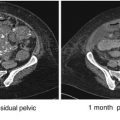© Springer International Publishing Switzerland 2017
Eric Pujade-Lauraine, Isabelle Ray-Coquard and Fabrice Lécuru (eds.)Ovarian Cancers10.1007/978-3-319-32110-3_2020. Small Cell Carcinoma of the Ovary
(1)
Département de médecine oncologique, Gustave Roussy, Université Paris-Saclay, F-94805, Villejuif, France
(2)
Gynecological Tumor Translational Research Laboratory, INSERM U981, Villejuif, France
Abstract
Small cell carcinoma of the ovary (SCCO) is a rare tumor in a very young population with a bad prognosis, even when diagnosed as stage 1A. Recent data suggest a possible implication of SMARCA4 gene in SCCOHT oncogenesis and suggest they may simply be an ovarian variant of malignant rhabdoid tumors. Multimodal approach including intensive chemotherapy, radical surgery and possibly radiotherapy is actually often proposed.
Small cell carcinoma of the ovary (SCCO) is a rare tumor that was first described by Dickersin and Scully in the 1980s [1, 2] and which usually affects young women and children. The incidence of these tumors is low, since they account for less than 1 % of ovarian cancers [3]. They grow very aggressively, and the majority of patients present with advanced stage disease and die rapidly (within 6 months); however, even those diagnosed as stage 1A share a poor prognosis with only 30–40 % of long-term survivors with standard treatment [4]. Potential prognostic factors, in addition to disease stage (stage IA versus others), are age >30 years, normal preoperative calcium level, a tumor size <10 cm, the absence of large cells, surgical resection including bilateral oophorectomy, and postoperative radiotherapy in some cases [5].
Unfortunately, most of the time, these tumors present at advanced stages (>stage IA) with a size exceeding 10 cm and in the second decade of life. SCCO is described as a highly aggressive tumor in a very young patient population (but often with rapid disease progression). In addition, there is no international consensus regarding the optimal treatment of SCCO, and a multimodal approach including chemotherapy, radical surgery, and possibly radiotherapy is often proposed. However, no randomized studies have ever been conducted, and the available published data are composed of case reports or small retrospective series with very heterogeneous management strategies. International guidelines were published in 2015 to help clinicians to offer the best therapeutic options [6].
Pathology
Two types of SCCO are now recognized in the WHO classification and have different clinical patterns. The hypercalcemic is the most common (SCCOHT) and non-small cell neuroendocrine carcinoma (large cell variant) which can be difficult to distinguish from the first one. Well-differentiated neuroendocrine tumors (carcinoids) are not fully discussed in this chapter and include classical primary carcinoid tumors of the ovary, which are equally uncommon [5, 7, 8]. SCCOHTs are the most frequent, tend to arise in younger women, with a mean age 28 years, and often present in nonsmokers.
SCCOHT is suspected when there is an undifferentiated ovarian carcinoma composed of small cells with scanty neoplasm occurring in a young patient and associated with hypercalcemia, which occurs in approximately 70 % of cases, but cannot be diagnostic. The large cell variant may cause some diagnostic confusion as may have a mixture of both large and small cells [6].
As tumors are highly undifferentiated, the histogenesis remained obscure (epithelial, germinal, or mesenchymatous), but most tumors display epithelial markers [5, 8]; interestingly, recent data suggest they may simply be an ovarian variant of malignant rhabdoid tumors [9, 10].
Until recently, literature describing the genomic profile of SCCOHT was scarce. However, recent publications have confirmed that there may be an identifiable molecular pathway in SCCO. Sequencing of cases with available DNA identified recurrent germ line or somatic deleterious SMARCA4 mutations, suggesting a possible implication of SMARCA4 in SCCOHT oncogenesis. Germ line mutations in SMARCA4 or SMARCB1 were already known to predispose to the development of pediatric tumors, namely, atypical teratoid/rhabdoid tumors [11, 12]. Mutations in the SWItch/Sucrose NonFermentable (SWI/SNF) chromatin-remodeling gene, SMARCA4 encoding BRG1, have now been shown to be a frequent event occurring in 76–100 % of SCCOHT tumors [13–15]. The SWI/SNF complex has been identified as a tumor suppressor that functions primarily by remodeling nucleosome structure and generating sites that are more or less accessible to DNA-binding factors. SWI/SNF acts as a master coordinator of gene activation and repression and appears to be particularly involved in regulating lineage-specific and differentiation gene expression programs [16, 17].
Inactivating germ line and somatic SMARCA4 mutations have been identified in SCCOHT in three papers published at the same time: the first one identified inactivating biallelic SMARCA4 mutations in 100 % of the 12 SCCOHT tumors examined [13]. Protein studies confirmed loss of the SWI/SNF chromatin-remodeling complex SMARCA4 expression, suggesting a key role in SCCOHT; the second one identified germ line and somatic inactivating mutations in the gene SMARCA4 in 75 % (9/12) of SCCOHT cases in addition to SMARCA4 protein loss in 82 % (14/17) of SCCOHT tumors, but in only 0.4 % (2/485) of other primary ovarian tumors [14]. In the third article, authors sequenced the exomes of six individuals from three families with SCCOHT [15]. After discovering segregating deleterious germ line mutations in SMARCA4, all the familial tumors sequenced harbored either a somatic mutation or loss of the wild-type allele. Immunohistochemical analysis of these cases and additional familial and nonfamilial cases showed loss of SMARCA4 (BRG1) protein in 38 of 40 tumors overall. Taken together, these data suggest that SMARCA4 loss of function mutations may have real diagnostic utility; the question is whether these mutations may also have therapeutic implications.
Until, there were no robust immunohistochemical diagnostic markers, SCCOHTs usually stain diffusely for WT1, which is of little diagnostic aid. The “gold standard” for diagnosis remains an evaluation by an expert pathologist. In France, all suspected SCCOHTs are centrally reviewed by a reference pathologist within the National Rare Ovarian Tumor Network [18]. The differential diagnosis included germ cell and granulosa/sex cord tumors, especially if they were more poorly differentiated. Given the diagnostic challenge frequently posed by these rare tumors.
Stay updated, free articles. Join our Telegram channel

Full access? Get Clinical Tree






